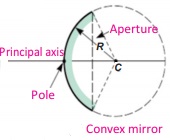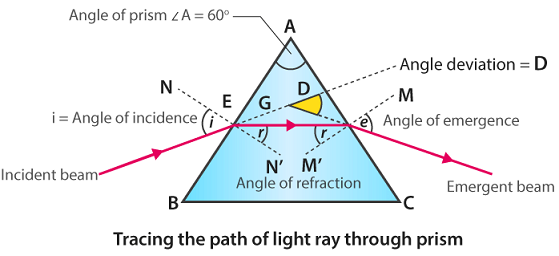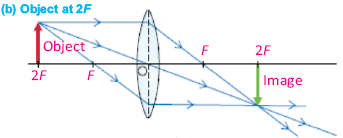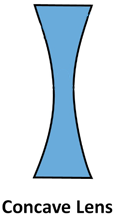Unit 12- Geometrical Optics (Short Questions)
Q.1 Write the laws of reflection of light.
Q.2 What is meant by regular reflection of light?
Q.3 What is the difference between regular and irregular reflection?
Q.5 Define pole and show it in diagram.
Q.6 Define principal focus and focal length.
Q. 7 Define convex mirror.
Q.8 Difference between convex and concave mirror.
Q.11 Describe the laws of light refraction.
Q.12 What is the refractive index of Water and Ice?
Q. 13 What is meant by total internal reflection?
Q.14 Write conditions of total internal reflection.
Q.15 How light travels with the use of total internal reflection in optical fiber?
Q.16 What is meant by Endoscope?
Q.17 What is meant by Endoscopy?
Q.18 Define cystoscope and gastroscope.
Q.19 What is Light Pipe?
Q.20 What is prism?
Q.21 Write two uses of optical fiber.
Q.22 What is meant by principle focus of a Convex and Concave lenses?
Q.23 What is meant by Power of Lens? Write its formula.
Q.24 How thickness of lens effects its focal length?
Q.25 What is difference between real and virtual images?
Q.26 Explain the use of lens in camera.
Q.27 Make diagram of photograph enlarger.
Q.28 Define terms resolving and magnifying power.
Q.29 Define following terms for lenses.
i) Principal axis ii) Optical center
Q.30 Draw the ray diagram of simple microscope.
Q.31 What is telescope?
Q.32 Write uses of compound microscope.
Q.33 Draw ray diagram for image formation in convex lens when object is beyond 2F.
Q.35 What is meant by near sightedness
Q.36 How farsightedness defect can be corrected?
Q.37 What is meant by concave lens? Draw its diagram.
Q.38 Define reflection of light. Also name the types of reflection.
Q.39 What is meant by irregular reflection of light?
Q.40 Define center of curvature and radius of curvature.
Q.41 Define Snell’s law. Write its formula.
Q.42 Define refractive index. What is its unit?
Q.44 Differentiate between core and cladding of’ a optical fiber.
Q.45 What is the function of’ gastroscope and bronchoscope?
Q.46 Define lens, write names of its two types.
Q.48 What are sign conversions of focal length for lenses?
Q.49 What is simple Microscope?
Q.50 Define Near point and Far point.
Q.51 Define compound microscope.
Q.52 What is meant by resolving power?
Q.53 Write down two characteristics of compound microscope.
Q.1 Write the laws of reflection of light.
Ans: There are two laws of reflection of light.
- The incident ray the normal and the reflected ray at the point of incidence all lie in the same plane.
Q.2 What is meant by regular reflection of light?
Ans: Regular reflection of light: The smooth surface reflects rays of the light in one direction only this reflection is ·called regular reflection.
Example: A smooth surface of silver reflects rays of light in one direction only. The reflection by these smooth surfaces is called regular reflection.
Q.3 What is the difference between regular and irregular reflection?
Ans: Irregular reflection: In this reflection the rough surfaces reflect the rays of light in many direction. This reflection is called irregular reflection.
Regular reflection: In regular reflection smooth surfaces reflect the light in one direction only. This reflection is called regular reflection.
Q.4 What is Spherical mirror?
Ans: Spherical Mirror: A mirror whose polished reflecting surface is a part of a hollow sphere of glass or plastic called spherical minor.
Q.5 Define pole and show it in diagram.
Ans: It is the midpoint of the curved surface of spherical mirror. It is also called vertex.

Q.6 Define principal focus and focal length.
Ans: Principal Focus: After reflection from a concave mirrors rays of light parallel to the principal axis converge to a point is called principle focus.
Focal length: It is the distance from the pole to the principal focus measured along the principal axis.
Formula: The focal length is related to the radius of curvature by: f = R / 2
This means that as the radius of curvature is reduced, so to is the focal length of the reflecting surface.
Q. 7 Define convex mirror.
Ans: Convex Mirror: A spherical minor whose outer curved surface is reflecting is called convex mirror.
Properties: In convex mirror the size of the image is always smaller than the object only virtual and erect image is formed by convex mirror.
Q.8 Difference between convex and concave mirror.
Ans: Convex Mirror: a. A spherical mirror whose outer curved surface is reflecting is called convex mirror.
b. In convex mirror the size of the image is always smaller than the object.
c. Only virtual and erect image is formed by a convex minor.
d. The focus lies behind the mirror.
Concave Mirror: a. A spherical mirror whose inner curved surface is reflecting is called
concave mirror.
b. In concave mirror the size of the image depends on the position of the object.
c. Both virtual and real image can be formed by a concave mirror.
d. The focus is in front of the mirror.
Q.9 Define mirror formula.
Ans: Mirror formula: Mirror formula is the relationship between object distance P, image distance q from the mirror and the focal length “f” of the
mirror.
Mathematical form:
![]()
It is for both concave and convex mirrors.
Q. 10 Why the position of fish inside the water seems to be at less depth than that of its actual position?
Ans: Due to refraction of light the position of fish inside the water seems to be at less depth than that its actual position.
Q.11 Describe the laws of light refraction.
Ans: Laws of refraction:
According to laws of refraction of light:
- The incident ray, the refracted ray and the normal at the point of incidence all lie in the same plane.
- ii) The ratio of the sin of the angle of. incidence “i” to the sin of the angle of refraction “r” is always equal to a constant i.e.
Q.12 What is the refractive index of Water and Ice?
Ans: The refractive index of ice is 1.31. Whereas refractive index of water is 1.33.
Q. 13 What is meant by total internal reflection?
Ans: Internal reflection: The angle of incidence for which the .angle of refraction becomes 90° is called critical angle. When the angle of incidence becomes larger than the critical angle, no refraction occurs. The entire light is reflected back into the denser medium. This is known as total internal reflection of light.
Q.14 Write conditions of total internal reflection.
Ans: There are two conditions for total internal reflection.
i) Angle of incidence is greater than critical angle i.e., i > C.
ii) Ray of light enters from denser to rare medium.
Q.15 How light travels with the use of total internal reflection in optical fiber?
Ans: In optical fiber light entering form one end of the core strikes the core- cladding boundary at an angle of incidence greater than critical angle and is
reflected back .into the core. In this way light travels many kilometres with small Joss of energy.
Q.16 What is meant by Endoscope?
Ans: Endoscope: An endoscope is a medical instrument used for exploratory diagnostics, and surgical purpose. An endoscope is used for explore the
interior organs of the body. Due to its small size, it can inserted through the
mouth and thus eliminates the invasive surgery.
Example: Gastroscope, Cystoscope and Bronchoscope.
Q.17 What is meant by Endoscopy?
Ans: Endoscopy: A medical procedure using any type of endoscope is called endoscopy.
Q.18 Define cystoscope and gastroscope.
Ans: Cystoscope: The cystoscope is used to examine the bladder.
Gastroscope: The gastroscope is used to examine the stomach internally.
Q.19 What is Light Pipe?
Ans: Light pipe is a bundle of thousand of Optical fibers bounded together. They are used to illuminate the inaccessible placed by the doctors or engineers.
For example, doctors view inside the human body. They also use light pipe to transmit image from one place to another.
Q.20 What is prism?
Ans: Prism: Prism is a transparent object made up of optical glass with at least two polished plane faces inclined towards each other from which light is
refracted.

Q.21 Write two uses of optical fiber.
Ans: Total internal reflection is used in fiber optics or optical fibers which has number of advantages in telecommunication field. Fiber optics consists of hair size threads of glass or plastic through which light can travel. Optical fiber is being used in telephone and. advanced communication systems due to which we can listen thousands of phone calls without any distribution.
Q.22 What is meant by principle focus of a Convex and Concave lenses?
Ans: i) Principle Focus of Convex Lens: The light rays travelling parallel to the principle axis of a convex lens after refraction meet at point on the principal axis called principal focus or focal point F. Hence, convex lens is also called converging lens.
ii) Principal Focus of Concave Lens: For a concave lens, the parallel rays appear to come from a point behind the lens called principal focus F.
Hence concave lens is also called diverging lens.
Q.23 What is meant by Power of Lens? Write its formula.
Ans: Power of Lens: Power of a lens is defined as the reciprocal of its focal length in metres.
Power of a lens = P = 1 / focal length in metres
The SI unit of power of a lens is “Dioptre”, denoted by a symbol D. If f is expressed in metres so that 1 D = 1 m-1 . Thus, 1 Dioptre is the power of a lens whose focal length is 1 metre. Because the focal length of a convex lens is positive, therefore, its power is also positive. Whereas the power of a concave lens is negative, for it has negative focal length.
Q.24 How thickness of lens effects its focal length?
Ans: A lens with more “bending power” has a shorter focal length, because it alters the path of the light rays more effectively than a weaker lens. … But for thicker lenses, how thick they are does make a difference, and in general, results in a shorter focal length.
Q.25 What is difference between real and virtual images?
Ans: virtual image is an image formed. When the outgoing rays from a point on an object always diverge. The image appears to be located at the point of apparent divergence.
Because the rays never really converge a virtual image cannot be projected on to a screen. your image in a mirror is example of virtual “image.
Real Image
A real image is an image which is located in the plane of convergence from a given object. If a screen is placed in the plane of a real image the image will general
become visible on the screen real image. Include the image seen on a cinema screen. The image produced on an eye
ball.retina etc.
Q.26 Explain the use of lens in camera.
Ans: A lens is a tool used to bring light to a fixed focal point. In a film camera, the lens sends the light to the film strip, while in a digital camera (like DSLRs or mirror less cameras), the lens directs light to a digital sensor.
Q.27 Make diagram of photograph enlarger.
Ans:

Q.28 Define terms resolving and magnifying power.
Ans: Resolving Power: The resolving power of an instrument is its ability to distinguish between two closely placed objects or point sources.
Magnifying power is defined as the ratio between the dimensions of the image and the object. The process of magnification can occur in lenses, telescopes, microscopes and even in slide projectors. Simple magnifying lenses are biconvex – these lenses are thicker at the center than at the edges.

Q.29 Define following terms for lenses.
i) Principal axis ii) Optical center
Ans: i) Principal axis: A line passing through the center of the surface of a lens or spherical mirror and through the centers of curvature of all segments of the lens or mirror.
ii) Optical center: A point on the axis of a lens that is so located that any ray of light passing through it in passing through the lens suffers no net deviation and that may be within, without, or on either surface of the lens.
Q.30 Draw the ray diagram of simple microscope.
Ans:

Ans: A telescope is an optical instrument that makes far away objects look closer by using a special arrangement of lenses and mirrors. An optical instrument you use to look at the stars that makes the stars appear closer is an example of a telescope.
Q.32 Write uses of compound microscope.
Ans: 1. Compound microscope is used to observe small objects.
2. Compound microscope-is used to study bacteria and other micro objects.
3. It is used for research in several fields of science like micro biology, botany, geology and genetics.
Q.33 Draw ray diagram for image formation in convex lens when object is beyond 2F.
Ans:

The image is behind the object virtual, erect larger than the object.
Q.34 Define accommodation.
Ans: The variation of focal length of eye leers to form a sharp image on retina is called accommodation. It is large in young people while it goes on decreasing with age.
Q.35 What is meant by near sightedness?
Ans: Near sightedness: Some people cannot see distant objects clearly without the aid of spectacles. This defect of vision is known as short sight or near
sightedness.
Q.36 How farsightedness defect can be corrected?
Ans: Farsightedness: The disability of the eye to from distinct images of nearby objects on its retina is known as farsightedness.
This defect can be corrected with the aid of a suitable converging lens. The lens refracts the light rays and they converge to form an image one the retina. To an observer, these rays appear to come from near point to form a sharp virtual image on the retina.
Q.37 What is meant by concave lens? Draw its diagram.
Ans: Concave lens: The type of lenses causes the parallel rays of light to diverge from a point is called concave lenses.

Q.38 Define reflection of light. Also name the types of reflection.
Ans: Reflection of light: When light travelling in a certain medium falls on the surface of another medium a part of it turns back in the same medium.
Name the types of’reflection:
i) Regular reflection ii) Irregular reflection
Q.39 What is meant by irregular reflection of light?
Ans: Irregular reflection of’ light: Rough surface reflected rays of light into different directions this type of reflection is called irregular reflection.
Explanation: Most of objects in everyday world are not smooth on the microscopic level. The rough surfaces of these objects reflect the rays of light in many directions such a type of reflection is called irregular reflection.
Q.40 Define center of curvature and radius of curvature.
Ans: Center of curvature: The point in the center of the sphere from which the mirror was sliced is known as the center of curvature and is denoted by the letter C.
Radius of curvature: The distance from the vertex to the center of curvature is known as the radius of curvature (represented by R)
Q.41 Define Snell’s law. Write its formula.
Ans: Snell’s law (also known as Snell–Descartes law and the law of refraction) is a formula used to describe the relationship between the angles of incidence and refraction, when referring to light or other waves passing through a boundary between two different isotropic media, such as water, glass, or air.
sini /sinr=constant=μ
Where i is the angle of incidence and r is the angle of refraction. This constant value is called the refractive index of the second medium with respect to the first.
Q.42 Define refractive index. What is its unit?
Ans: Refractive index, also called index of refraction, measure of the bending of a ray of light when passing from one medium into another. Refractive index is also equal to the velocity of light c of a given wavelength in empty space divided by its velocity v in a substance, or n = c/v.
Q.43 Define optical fiber.
Ans: An optical fiber is a cylindrical dielectric wave guide (nonconducting wave guide) that transmits light along its axis, by the process of total internal reflection. The fiber consists of a core surrounded by a cladding layer, both of which are made of dielectric materials.
Q.44 Differentiate between core and cladding of’ a optical fiber.
The core is usually made of glass or plastic. The core is the light-carrying portion of the fiber.
The cladding surrounds the core. The cladding is made of a material with a slightly lower index of refraction than the core.
Q.45 What is the function of’ gastroscope and bronchoscope?
Ans: The gastroscope is used to examine the stomach internally.
Branchoscope: Bronchoscope is used to examine the throat infection.
Q.46 Define lens, write names of its two types.
Ans: Lens: A lens is any transparent material having two surfaces, of which at least one is curved. Lenses refract light in such a way that an image of the
object is formed.
Types of’lens
i) Concave lens ii) Convex lens
Q.47 Describe the image formation in convex lens with the help of three basic rays when the object is at 2F.
Ans:

Q.48 What are sign conversions of focal length for lenses?
Ans: Focal Length: f is the distance between the optical center and the principal focus.
i ) f is positive for a converging lens. ii) f is negative for a diverging lens.
Q.49 What is simple Microscope?
Ans: A simple microscope is one that uses a single lens for magnification, such as a magnifying glass while a compound microscope uses several lenses to enhance the magnification of an object.
Q.50 Define Near point and Far point.
Ans: Near point: The near point of the eye is the minimum distance of an object from the eye at which it produces a sharp image on the retina.
Far point: The far point of the eye is the maximum distance of distant object from the eye 011 which the fully relaxed eye can focus.
Q.51 Define compound microscope.
Ans: An optical instrument for forming magnified images of small objects, consisting of an objective lens with a very short focal length and an eyepiece with a longer focal length, both lenses mounted in the same tube.
Q.52 What is meant by resolving power?
Ans: The resolving power of an instrument is its ability to distinguish between two closely placed object or point sources.
Q.53 Write down two characteristics of compound microscope.
Ans: The characteristics of compound microscope are following:
- Two or more convex lenses.
- Typical magnification range between 40x and 1000x.
- One objective is used at a time.
- Two-dimensional images.
Q.54 Define magnifying power.
Ans: Magnifying power is defined as the ratio between the dimensions of the image and the object. The process of magnification can occur in lenses, telescopes, microscopes and even in slide projectors. Simple magnifying lenses are biconvex – these lenses are thicker at the center than at the edges.
